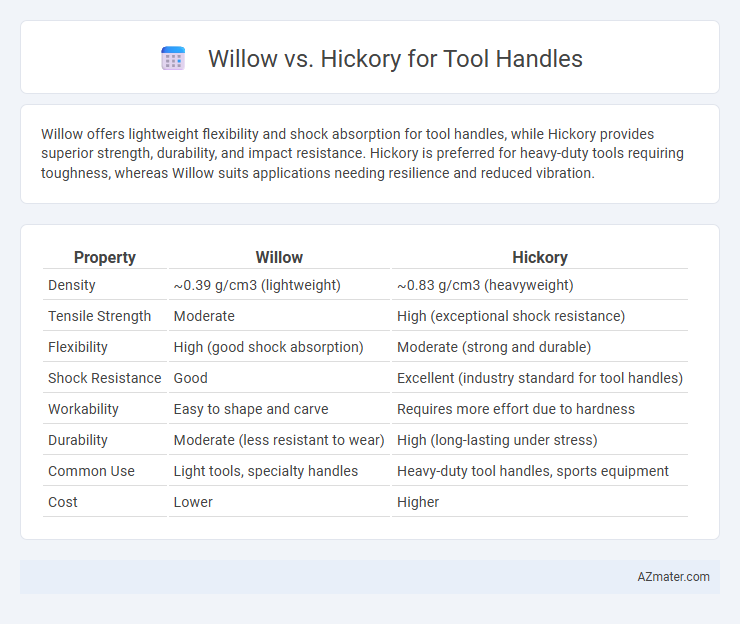Willow offers lightweight flexibility and shock absorption for tool handles, while Hickory provides superior strength, durability, and impact resistance. Hickory is preferred for heavy-duty tools requiring toughness, whereas Willow suits applications needing resilience and reduced vibration.
Table of Comparison
| Property | Willow | Hickory |
|---|---|---|
| Density | ~0.39 g/cm3 (lightweight) | ~0.83 g/cm3 (heavyweight) |
| Tensile Strength | Moderate | High (exceptional shock resistance) |
| Flexibility | High (good shock absorption) | Moderate (strong and durable) |
| Shock Resistance | Good | Excellent (industry standard for tool handles) |
| Workability | Easy to shape and carve | Requires more effort due to hardness |
| Durability | Moderate (less resistant to wear) | High (long-lasting under stress) |
| Common Use | Light tools, specialty handles | Heavy-duty tool handles, sports equipment |
| Cost | Lower | Higher |
Introduction to Willow and Hickory Tool Handles
Willow tool handles offer a lightweight and flexible option ideal for tasks requiring shock absorption and reduced user fatigue. Hickory tool handles are renowned for their exceptional strength, durability, and resistance to impact, making them a preferred choice for heavy-duty applications. Both woods provide natural resilience, with willow excelling in flexibility and hickory dominating in toughness for tool handle construction.
Wood Properties: Willow vs Hickory
Hickory boasts superior strength and shock resistance, making it an ideal choice for tool handles subjected to heavy impact and stress. Willow, while lighter and more flexible, lacks the density and durability of hickory, resulting in less long-term resilience. The high density and hardness of hickory provide better wear resistance and grip stability compared to the softer, less rigid willow wood.
Durability and Strength Comparison
Hickory offers superior durability and strength compared to willow, making it the preferred choice for tool handles subject to heavy impact and stress. Its dense grain structure provides excellent shock resistance and longevity, while willow, being lighter and softer, is more prone to wear and breakage under intense use. For applications demanding robust performance and extended service life, hickory remains the optimal selection.
Shock Absorption Qualities
Willow wood offers superior shock absorption qualities compared to hickory, making it ideal for tool handles that require vibration dampening. The lower density and fibrous structure of willow reduce impact stress on the user's hands during repetitive use. Hickory, while durable and tough, transmits more shock due to its higher density and stiffness, potentially increasing hand fatigue over extended periods.
Weight and Handling Differences
Willow tool handles are significantly lighter than hickory, reducing user fatigue during extended use. Hickory offers superior strength and shock absorption, making it ideal for heavy-duty tasks despite its heavier weight. The lightweight nature of willow enhances maneuverability and control, while hickory's density provides durability and impact resistance.
Workability and Shaping Ease
Willow offers superior workability and shaping ease due to its lightweight, soft texture, and fine grain, allowing for smooth cutting and minimal tool wear. Hickory, while denser and tougher, requires more effort to shape but provides exceptional durability and shock resistance. For intricate designs and frequent reshaping, willow is preferred, whereas hickory suits heavy-duty, long-lasting tool handles.
Resistance to Weather and Wear
Willow tool handles exhibit moderate resistance to weather but tend to absorb moisture, leading to swelling and potential weakening over time, making them less ideal for prolonged outdoor use. Hickory is renowned for its superior durability and high resistance to weather and wear, maintaining structural integrity even under harsh conditions and repeated heavy use. The dense grain and natural oils in hickory contribute to its excellent shock absorption and resistance to splitting, significantly enhancing the lifespan of tool handles exposed to varying environmental stresses.
Cost and Availability Factors
Willow tool handles tend to be more affordable due to the wood's faster growth rate and widespread availability, making it a cost-effective choice for mass production. Hickory, prized for its exceptional strength and shock absorption, commands a higher price and may be less readily available depending on geographical location. Choosing between willow and hickory handles often hinges on balancing budget constraints with the need for durability and performance in heavy-duty tool applications.
Best Applications for Willow vs Hickory Handles
Willow handles excel in shock absorption and lightweight design, making them ideal for tools requiring fine control and repeated impact, such as hammers used in woodworking or delicate demolition. Hickory handles offer superior strength, durability, and stiffness, making them the preferred choice for heavy-duty applications like axes, sledgehammers, and mauls that endure high stress and torque. Choosing willow enhances user comfort during prolonged use, while hickory maximizes power transmission for demanding tasks.
Choosing the Right Wood for Your Tool Handle
Willow and hickory offer distinct benefits for tool handles, with hickory providing superior strength, shock resistance, and durability, making it ideal for heavy-duty applications like axes and hammers. Willow is lighter and more flexible, suitable for tools requiring less impact resistance, such as lightweight handles or decorative purposes. Choosing the right wood depends on the tool's intended use, where hickory is preferred for longevity and performance while willow offers ease of handling and reduced fatigue.

Infographic: Willow vs Hickory for Tool Handle
 azmater.com
azmater.com